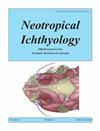巴西东南部沿海大西洋森林黑水溪流中鱼类对多种鳞片的反应
IF 2
4区 生物学
Q1 ZOOLOGY
引用次数: 0
摘要
环境因子在多个空间尺度上以层次的方式影响着生物群的组织。然而,不同尺度相关因子的相对影响知之甚少,特别是在大西洋森林黑水溪流中。因此,本研究旨在评价自然条件下大西洋沿岸14条黑水休养河流鱼类群落的局地因素、景观因素和空间因素,并验证低降水季节4个子流域的物种发生格局。当我们结合局部、景观和空间因素时,方差划分解释了物种矩阵中较高比例的变异。局部变量pH和总溶解固形物解释了大部分变异,这是决定鱼类群落结构的最重要因素。4个子流域的鱼类组合结构存在显著差异,其中对这种差异贡献最大的是Mimagoniates microlepis、Phalloceros harpagos和Hollandichthys multifasciatus。当地预测因子的重要贡献、记录的大量特有物种、濒危物种(Spintherobolus broccae)的存在以及接近原始的条件,可以作为评估类似环境的基线条件。本文章由计算机程序翻译,如有差异,请以英文原文为准。
Fish responses to multiple scales in coastal blackwater Atlantic Forest streams in Southeast Brazil
Abstract Environmental factors act at multiple spatial scales in a hierarchical manner to shape the organization of biota. However, the relative influence of different scale-related factors is poorly known, especially in Atlantic Forest Blackwater streams. Therefore, we herein aimed to evaluate local, landscape and spatial factors that shape fish assemblages in 14 blackwater restinga coastal Atlantic Forest streams under natural conditions and verify species occurrence patterns among four sub-basins during the low-precipitation season. When we combined local, landscape and spatial factors, variance partitioning explained a high proportion of variation in species matrix. Local variables pH and Total Dissolved Solids explained most of the variability, and these were the most important factors in determining fish community structure. Significant differences in fish assemblage structure among the four sub-basins were observed, and Mimagoniates microlepis, Phalloceros harpagos, and Hollandichthys multifasciatus were the species that most contributed to this dissimilarity. The important contribution of local predictors, the high number of endemic species herein recorded, the presence of an endangered species (Spintherobolus broccae), and near pristine conditions, may be used as baseline conditions for the assessment of similar environments.
求助全文
通过发布文献求助,成功后即可免费获取论文全文。
去求助
来源期刊

Neotropical Ichthyology
生物-动物学
CiteScore
2.80
自引率
17.60%
发文量
24
审稿时长
6-12 weeks
期刊介绍:
Neotropical Ichthyology is the official journal of the Sociedade Brasileira de Ictiologia (SBI). It is an international peer-reviewed Open Access periodical that publishes original articles and reviews exclusively on Neotropical freshwater and marine fishes and constitutes an International Forum to disclose and discuss results of original research on the diversity of marine, estuarine and freshwater Neotropical fishes.
-Frequency: Four issues per year published only online since 2020, using the ‘rolling pass’ system, which posts articles online immediately as soon as they are ready for publication. A searchable and citable Digital Object Identifier (DOI) is assigned to each article immediately after online publication, with no need to await the issue’s closing.
-Areas of interest: Biology, Biochemistry and Physiology, Ecology, Ethology, Genetics and Molecular Biology, Systematics.
-Peer review process: The Editor-in-Chief screens each manuscript submitted to Neotropical Ichthyology to verify whether it is within the journal’s scope and policy, presents original research and follows the journal’s guidelines. After passing through the initial screening, articles are assigned to a Section Editor, who then assigns an Associate Editor to start the single blind review process.
 求助内容:
求助内容: 应助结果提醒方式:
应助结果提醒方式:


